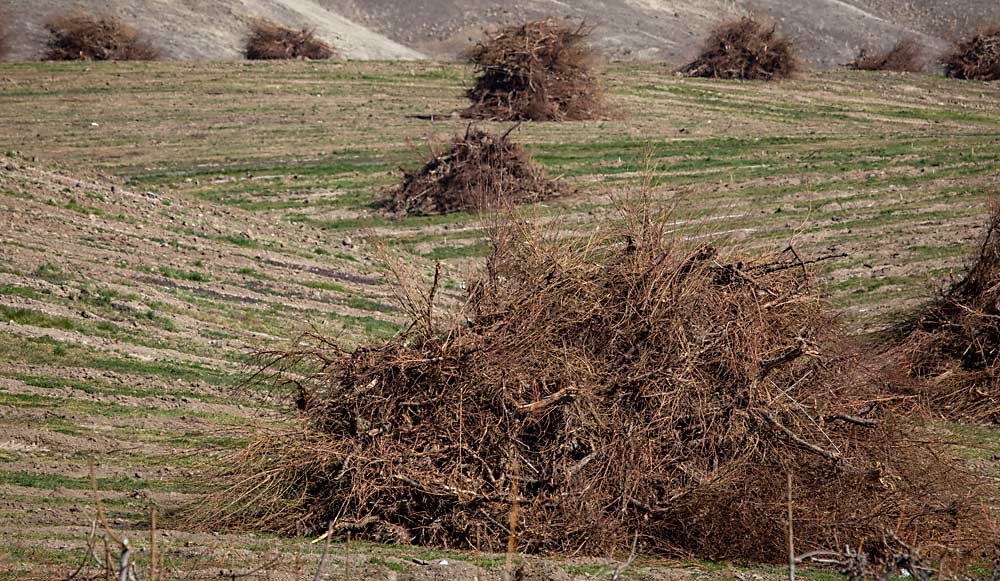
Orchard owners pulled out over 800 acres of peaches and nectarines in Washington’s Yakima Valley this winter, after discovering widespread X disease infection in a crop that was already struggling to remain competitive with California producers.
The lost acreage will cut Washington’s expected soft fruit harvest from about 20,000 tons in recent years to just 10,000 tons, said B.J. Thurlby, president of the Washington State Fruit Commission. At that level, the commission can’t really run an effective marketing program, he told the commission board in March.
So, with the encouragement of the primary remaining producer, the board voted to halt assessments on soft fruit — peaches, nectarines, apricots, prunes and plums — for marketing for the 2020 season. The move leaves the assessment for research intact, with the possibility of collecting marketing assessments again if growers start planting more soft fruit someday. The commission will lean on its reserves this season to match the Market Access Program funds the soft fruit program had already received from the U.S. Department of Agriculture this year.
After the X disease-driven removals, Douglas Fruit of Pasco now grows about 75 percent of the state’s soft fruit, Thurlby said.
Jill Douglas, the company’s co-president and member of the commission’s board, said that, at this point, the company would rather just fund its own promotions. Douglas Fruit, which markets through Stemilt, grows and packs all organic soft fruit.
Douglas Fruit also pulled an orchard due to X disease, she said. For several years, they couldn’t figure out why the block was struggling, before the tests came back positive for X disease last season. But so far, the rest of the company’s orchards seem healthy.
“They should have a good market in the Northwest,” Thurlby said in a subsequent interview. Demand for locally grown fruit in the state remains strong, he said. “People are still going to be out there asking for Washington peaches, nectarines and apricots. And when people ask our cherry reps, we’re still going to say we love them, because we do.”
Even before the widespread discovery of disease symptoms, the market has been tough for Washington’s soft fruit growers for several years. California’s season has extended through new varieties that filled the market gap Washington growers used to enjoy, and so growers have generally been pulling out older peach and nectarine blocks and not replanting, Thurlby said.
Finding X disease just accelerated that trend.
What is known
In Northwest cherry orchards, X disease is at epidemic levels. The phytoplasma pathogen causes little cherry disease, as does another, more aptly named pathogen, little cherry virus, resulting in small, unripened, unmarketable fruit. The phytoplasma that causes X disease is spread by leafhopper vectors, which are often active in orchards after harvest in the fall.
In other stone fruit, there’s been far less sampling than in cherry, said Scott Harper, Washington State University virologist and director of the Clean Plant Center Northwest. Last year, with funding from the Washington Tree Fruit Research Commission, he began studying the prevalence and impacts of two phytoplasmas in stone fruits: X and peach yellow leafroll.
At sites where growers reported symptoms, he found 20 to 30 percent of the trees were infected with one or both pathogens.
“In a high percentage of cases, it turns out the trees had both,” Harper said. Symptoms for both pathogens are similar: Fruit doesn’t mature or is low-quality, but unlike in cherries, the trees also decline quickly.
“In some ways, it’s worse than you get in the cherries. One thing you do see in peaches is the tree starts dying and declining very quickly. It will start dying within three to five years,” Harper said. “You will lose your block a lot faster because the trees will die.”
Whether the phytoplasma at fault is X or peach yellow leafroll, which is also known for causing pear decline, the solution is the same: pull out symptomatic trees as soon as possible. No cure exists, but growers can reduce the spread.
On the research front, he’s trying to work in parallel with the research being done in cherries, to better understand the biology of the pathogens, their vectors and the genetics that underlie why different stone fruit show different symptoms.
—by Kate Prengaman






Leave A Comment